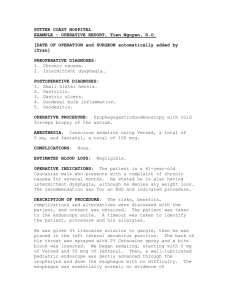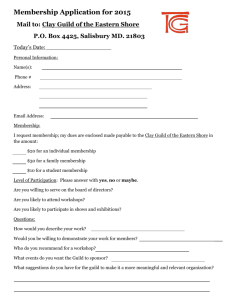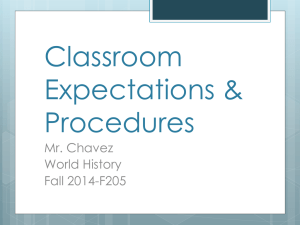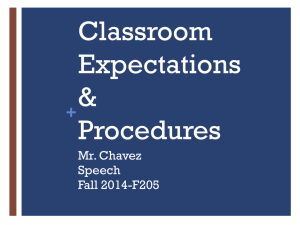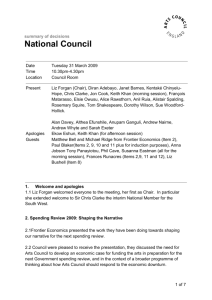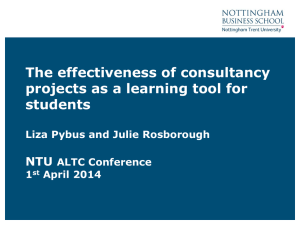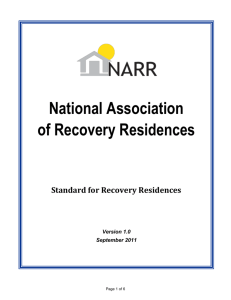9 December 2010 - University of Exeter
advertisement
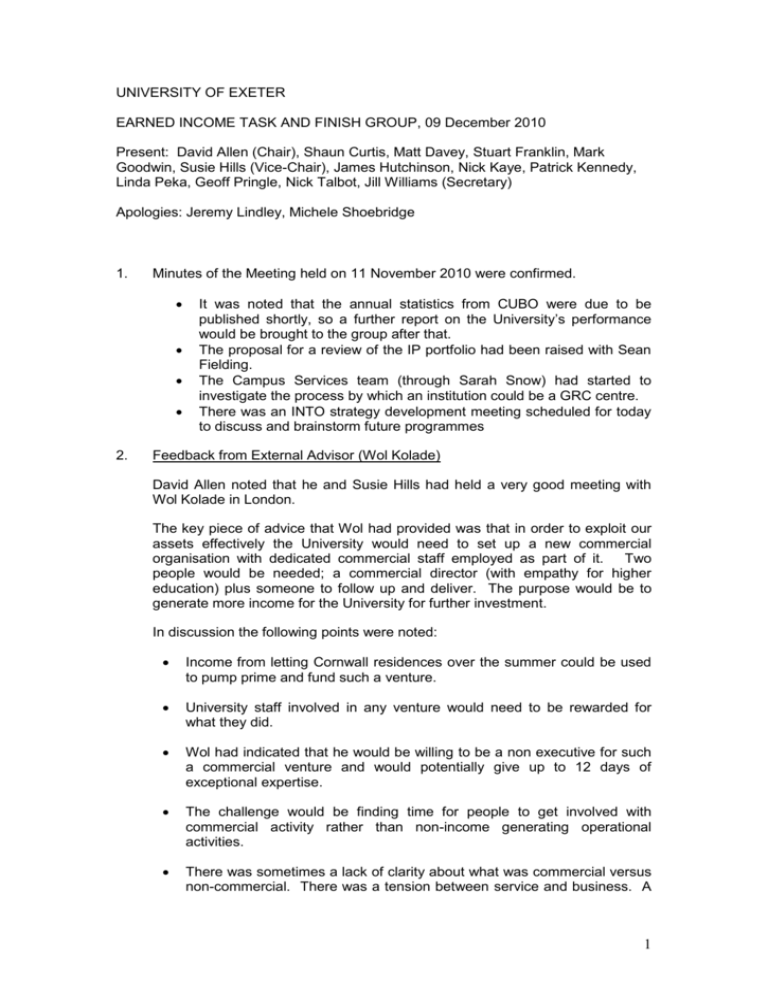
UNIVERSITY OF EXETER EARNED INCOME TASK AND FINISH GROUP, 09 December 2010 Present: David Allen (Chair), Shaun Curtis, Matt Davey, Stuart Franklin, Mark Goodwin, Susie Hills (Vice-Chair), James Hutchinson, Nick Kaye, Patrick Kennedy, Linda Peka, Geoff Pringle, Nick Talbot, Jill Williams (Secretary) Apologies: Jeremy Lindley, Michele Shoebridge 1. Minutes of the Meeting held on 11 November 2010 were confirmed. 2. It was noted that the annual statistics from CUBO were due to be published shortly, so a further report on the University’s performance would be brought to the group after that. The proposal for a review of the IP portfolio had been raised with Sean Fielding. The Campus Services team (through Sarah Snow) had started to investigate the process by which an institution could be a GRC centre. There was an INTO strategy development meeting scheduled for today to discuss and brainstorm future programmes Feedback from External Advisor (Wol Kolade) David Allen noted that he and Susie Hills had held a very good meeting with Wol Kolade in London. The key piece of advice that Wol had provided was that in order to exploit our assets effectively the University would need to set up a new commercial organisation with dedicated commercial staff employed as part of it. Two people would be needed; a commercial director (with empathy for higher education) plus someone to follow up and deliver. The purpose would be to generate more income for the University for further investment. In discussion the following points were noted: Income from letting Cornwall residences over the summer could be used to pump prime and fund such a venture. University staff involved in any venture would need to be rewarded for what they did. Wol had indicated that he would be willing to be a non executive for such a commercial venture and would potentially give up to 12 days of exceptional expertise. The challenge would be finding time for people to get involved with commercial activity rather than non-income generating operational activities. There was sometimes a lack of clarity about what was commercial versus non-commercial. There was a tension between service and business. A 1 much clearer agenda would be needed in terms of what we do, how we deliver it and the resources put in. Members were keen to look at a new model. 3. The terms of reference for such a venture would need to be clearly defined and this would help de-lineate a lot better the current activities and what assets would be included / not included. The bottom line would be the key driver for these activities – whereas there is currently more of a balanced scorecard. Research / IP would be kept separate as this was about exploiting physical assets. But, the same process might be applicable in research & development. There was appetite in the Colleges to do this. Amongst technical staff there would also be some skills that could be ‘sold’. There was a bigger cultural change needed amongst staff and this would take 2-3 years. The shift required should not be under-estimated and the work must not fall to the same people all the time. The issue was likely to be prioritising all the ideas that would be generated. There would need to be a process to do this. It would be intended that the people employed would be on different terms and conditions. The cost base would be kept down and salary would be performance related. There would also need to be a mechanism for rewarding those who were involved from the University. A business plan would need to be developed for the venture and agreed with Colleges and Professional Services along commercial lines. Wol had agreed to attend the next meeting of the group and would be willing to help finalise the report. Les Halpin would also provide input. It was noted that there could be a good opportunity to partner with Lightfoot Solutions to help them penetrate the HE market. This could create a revenue stream. It was also noted that the potential for shared services with Bristol was extremely speculative at this stage and Commercial in Confidence. Production of the report Members were content with the proposed timetable for production of the group’s report. 4. Income from physical assets Geoff Pringle introduced this item to the group and the following key points were noted: Residences 2 £13-14m was currently being generated from residential holdings. The University did not seek to profit but to make a surplus. Residences accounted to support other activities at the University. There was a significant backlog maintenance issue with some residences. The residences strategy post-UPP was being developed. There were different models that could be pursued with off-campus residences and opportunities for capital return. There would be increasing values of city centre property as the city developed. The University still had to provide 75% of additional residency requirement. Different packages for students would be looked at to meet student needs in the future. Third parties were likely to look for a minimum of 42 weeks occupation / lease. Vacations The University had a successful conference operation with academic / associations / societies plus visitors to the South West. The bed income from conferences was currently £1.3m, plus the catering income on top of this. Retail Services (including print) Retail services generated £5.3m income for the University currently. However, this was provided as a service and money was being lost on certain activities. This was compensated by profits in other areas e.g. the supermarket. The net profit was not significant. Challenges The terms under which staff were employed was not commercial. This resulted in salary cost issues. The scale of activity at St Luke’s was resulting in losses. Footfall at certain times of the year was low and this resulted in a need for flexible contract hours for staff in campus services. There were 1600 catered places in student residences. This was an expensive operation to run and was being reviewed as part of the Russell Partnership work. Fewer Universities were providing this offering now but this could provide an opportunity for a niche offering at Exeter. Reed Hall was profitable and there were plans to grow this business. The meeting and functions business was profitable. David Allen noted that there could be some quite big decisions for Campus Services. The University would have to think about facilities management and how it was delivered, and consider how to invest in the student experience. We would need to look at changing the way that services were delivered. However, it was critical to maintain a group of staff who cared about the student experience. 3 James Hutchinson noted the following points: Guild staff operated under separate contracts as the Guild was a separate vehicle. In the past the contracts mirrored those of the University but this was now starting to change. They were still more generous than the high street though. Students were looking for value for money and efficiency. Products and services needed to be enhanced to meet their expectations. Employment of students as staff was very beneficial due to the flexibility it gave the Guild. The Guild generated around £2.1m in total from retail (£500-600k), catering, lettings, marketing, licence trade (£600-700k) and events. For retail operations you would ideally want an entirely flexible contract staff with sales targets. Overall the University needed to consider what every student / graduate was willing to spend money on and whether we were providing this. The lack of footfall would be an issue for any commercial operator in a retail environment. 5. Income from intellectual assets a) Income from Academic Consultancy Quite a lot of consultancy was already undertaken. Staff were able to do up to 10 days work at their Dean’s discretion. However, it was not known how much was done and there was no check on this. A review of academic consultancy was proposed. This would look at: o Are the right arrangements in place for negotiating rates and support for developing revenue streams o The scale of activity o Providing a simple gateway to ensure cover, appropriate rewards and enabling staff to ‘just get on with it’. There was a need for this to be more service orientated. Geography had implemented a system that could be looked at for good practice. This tried to ensure the School as well as the individual derived benefit from the consultancy. Exeter Enterprises did not currently make a material income. It was established to pump prime activities. The level of overhead applied by Exeter Enterprises was an issue. Experimental officers – there was quite a capacity for consultancy income from this group. It would be useful to stretch the family of staff that were covered by this. Use of technical equipment could also be included. 4 There was an appetite to review recommendation of the group’s report. private consultancy as a b) Income from Professional Services PSMG would work on what activities were valuable e.g. fundraising, top 10 planning etc. There would need to be a balance between what could be sold and security of competitive information. 6. SWOT analysis on part time provision Laura Ottery attended for this item. Changes to Higher Education funding were going to see different models evolve to meet different needs of students. Part time students would now be funded and this was a significant change to the market. Laura introduced the paper and noted the University’s key strengths, weaknesses, opportunities and threats. In discussion with members the following points were recorded: The University needed to be clear about what its niches and distinct strengths were. We would need to be selective about any opportunities we wanted to test. The campus in Cornwall provided an obvious opportunity – potentially including pre term sessions in September. As we move towards a mixed provision of staff there would be more opportunity for teaching over the summer. This was one of the few opportunities to do something with physical and human assets together Other kinds of activity could be generated – the creative agenda in particular. Linking in outside artists etc. to the institution could be effective. Current students at NYU could get credit for doing additional courses in the summer. The capacity to address different audiences through PT provision was the real benefit and could drive income. Some market research work on this would need to be done to establish what the market wanted. The University had a mixed history with CPD. It was not centralised and supported as an asset by the University. This would need to be looked at in depth if it was to develop. INTO had identified the CPD market as a potential 5-6 week international market. A package around Sustainability / the Met Office / ESI could be put together With ELE now in place, learning resources were completely portable for distance learning. Part time study in the summer could be attractive for full time students and could also add value to the use of residences. The impact of PT students on widening participation would be useful context for OFFA arrangements but PT students did not count towards benchmarking figures. 5 A joined up discussion with the Academic Year Task and Finish Group would be required. Any developments would need to be approached from the demand side. Student finance would only apply for part time students doing degree level courses. Therefore any courses developed would need to lead to a degree or be attractive enough that students would be willing to pay for them. Members agreed that in principle there was an appetite to explore opportunities for part time provision further. This would help with a 52 week economy which was essential for the future business model. 7. Date of next meeting Friday 14th January, 2010, 12-2pm John Usher Room, Northcote House. 6

